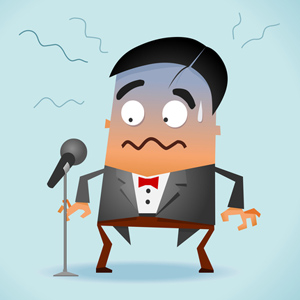Does this sound familiar? Feet resolutely frozen to the floor, white-knuckled hands glued to the lectern, abject fear written all over your face? If this sounds like you, then it is time you learned how to ‘let go and let be’ in public speaking.
When I talk about color – the life, the animation, the emotion we express in public speaking – I am talking about more than what your voice is saying. Much of how we express ourselves is seen in our body language. The question is: what is your body saying when you deliver your speech or presentation?
I once had a student who stood perfectly still next to the overhead projector as she delivered her stilted presentation, nary a muscle moving aside from her lips. I doubt she even blinked. Her only ‘extracurricular’ movement occurred when she had to change the slides, at which point she stopped talking, maneuvered the slide, proceeded to resume her frozen stance, and then continued speaking.
This young lady received an F on that particular presentation because she did not do what she had been instructed to do. She never moved. She never glanced throughout the classroom. She never acknowledged her audience. While her presentation was flat and emotionless, it was word-for-word perfect. She made no mistakes in that respect.
Her lack of body movement as well as any form of expression, however, was the mistake.
Dynamic speakers keep their audience riveted; and, in doing so, are able to keep their audience on the edge of their seats. Should you stand at the lectern and not move, your audience will. Their movement signals their boredom with you as a speaker. The more bored your audience, the greater the amount of movement on their part.
In addition, if you remain perfectly still, clutching the lectern in a death grip, your audience will be aware of your obvious fear and will focus on your discomfort and not on your message.
The best means of incorporating body language into your delivery is:
- By allowing yourself to move as speak. If you are standing at a lectern, just switching your weight from one foot to the other will allow for the greater ease in speaking. If you are not using a lectern, on the other hand, moving throughout the stage or floor area will produce the same release in tension. (I’m not talking about pacing back and forth which becomes distracting for your audience.)
- By using hand gestures as you talk which will help relax your body.
- By making eye contact with your audience and treating your listeners as if you were having a conversation in your living room. In doing so, you will be talking to your audience and not at them.
When it comes to your body language, if you ‘let go and let be,’ you will then be able to focus on what you are saying and not on your nervousness.

